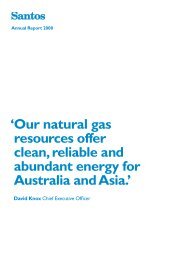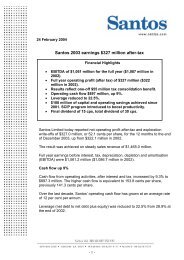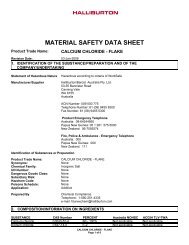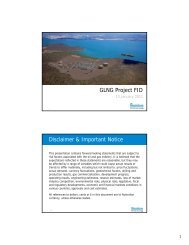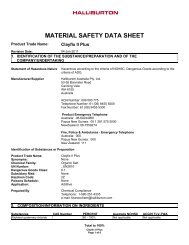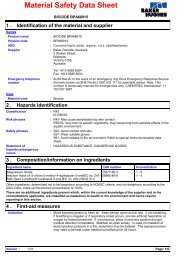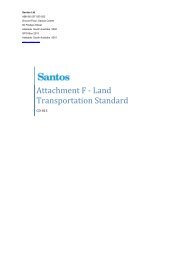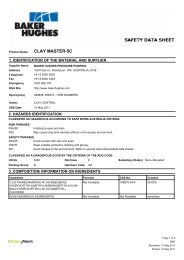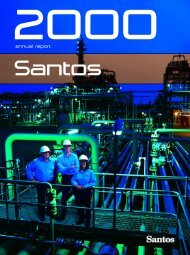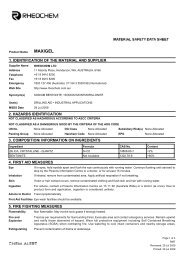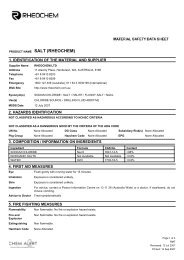SAFETY DATA SHEET - Santos
SAFETY DATA SHEET - Santos
SAFETY DATA SHEET - Santos
You also want an ePaper? Increase the reach of your titles
YUMPU automatically turns print PDFs into web optimized ePapers that Google loves.
<strong>SAFETY</strong> <strong>DATA</strong> <strong>SHEET</strong><br />
(Australia)<br />
According to the criteria of NOHSC:2011(2003)<br />
Version: 1 Revision date: 18 March 2011<br />
1. IDENTIFICATION OF THE SUBSTANCE/PREPARATION AND THE<br />
COMPANY/UNDERTAKING<br />
Product Name:<br />
Product Code:<br />
Company Identification:<br />
Emergency Telephone Number:<br />
Foaming Agent F104<br />
F104<br />
Schlumberger Oilfield Australia Pty Ltd<br />
ABN: 74 002 459 225<br />
ACN: 002 459 225<br />
256 St. Georges Terrace, Perth WA 6000<br />
1-800-039-008 (24hr)<br />
Use of the Substance/Preparation:<br />
Surfactant in oilfield applications.<br />
2. HAZARDS IDENTIFICATION<br />
Indication of danger:<br />
Most important hazards<br />
R-phrase(s):<br />
Risk Combination Phrases<br />
Xn - Harmful.<br />
Flammable. Irritating to eyes.<br />
Also harmful by inhalation, in contact with skin and if swallowed<br />
S-phrase(s):<br />
Safety Combination Phrases:<br />
Environmental hazard:<br />
Main physical hazards:<br />
S16 - Keep away from sources of ignition - No smoking. S46 - If swallowed, seek<br />
medical advice immediately and show this container or label.<br />
S24/25 - Avoid contact with skin and eyes.<br />
None known<br />
Flammable Liquid.<br />
3. COMPOSITION/INFORMATION ON INGREDIENTS<br />
Component CAS-No EC-No. Weight % - Classification<br />
Range<br />
Ester salt Listed 30 - 60 Xi;R36<br />
2-butoxyethanol 111-76-2 203-905-0 10 - 30 Xn:R20/21/22<br />
Xi;R36/38<br />
Ethanol 64-17-5 200-578-6 10 - 30 F;R11<br />
For the full text of the R phrases mentioned in this Section, see Section 16<br />
Page 1 of 7
Version: 1/AUSL<br />
Product Code: F104<br />
________________________________________________________________________________________<br />
4. FIRST AID MEASURES<br />
Inhalation:<br />
Skin contact:<br />
Eye contact:<br />
Move to fresh air in case of accidental inhalation of vapours. Seek medical attention if<br />
irritation occurs. If you feel unwell, seek medical advice (show the label where<br />
possible).<br />
Take off contaminated clothing and shoes immediately. After contact with skin, wash<br />
immediately with plenty of soap and water for at least 15 minutes.<br />
Immediately flush eyes with water for 15 minutes while holding eyelids open. Seek<br />
medical attention.<br />
Ingestion: Do NOT induce vomiting. If delayed, consider giving activated charcoal in water, or 2<br />
glasses milk or water. Seek medical attention at once.<br />
Notes to physician:<br />
none.<br />
5. FIRE-FIGHTING MEASURES<br />
Suitable extinguishing media:<br />
Extinguishing media which must not be used for safety<br />
reasons:<br />
Water Fog, Alcohol Foam, CO2, Dry Chemical.<br />
None known.<br />
Special protective equipment for firefighters:<br />
Wear protective fire fighting clothing and avoid breathing<br />
vapors. Use self-contained breathing apparatus in closed<br />
areas. Vapours are heavier than air and may spread along<br />
floors.<br />
Special exposure hazards arising from the substance or<br />
preparation itself, its combustion products, or released<br />
gases:<br />
Thermal decomposition can lead to release of irritating gases<br />
and vapours. Vapors may travel along the ground and ignite<br />
when an ignition source is contacted.<br />
6. ACCIDENTAL RELEASE MEASURES<br />
Personal precautions:<br />
Environmental precautions:<br />
Methods for cleaning up:<br />
Do not get on skin or clothing. Wash thoroughly after<br />
handling. Wear suitable protective equipment.<br />
Keep out of waterways. Prevent entry into sewage.<br />
Contain with dikes. Use explosion proof equipment to recover.<br />
Remove all sources of ignition. Soak up residual on inert<br />
absorbant (sand). Put in steel or plastic drum approved for<br />
flammables.<br />
7. HANDLING AND STORAGE<br />
Handling:<br />
Technical measures/Precautions:<br />
Keep away from heat, sparks, and flame. Ensure adequate<br />
ventilation.<br />
Page 2 of 7
Version: 1/AUSL<br />
Product Code: F104<br />
________________________________________________________________________________________<br />
Safe handling advice:<br />
Wear suitable protective equipment. Avoid contact with skin<br />
and eyes. Keep airborne concentrations below exposure<br />
limits. Keep away from heat, sparks, and flame.<br />
Storage:<br />
Technical measures/Storage conditions:<br />
Packaging requirements:<br />
Incompatible products:<br />
Store in well ventilated area out of direct sunlight. Keep<br />
containers tightly closed in a dry, cool and well-ventilated<br />
place. Store in a covered secondary containment chemical<br />
storage area. Keep away from open flames, hot surfaces and<br />
sources of ignition.<br />
Coated (epoxy phenolic) steel drum or high density<br />
polyethylene (HDPE) can.<br />
Oxidizing agents, Strong bases, Bases<br />
8. EXPOSURE CONTROLS / PERSONAL PROTECTION<br />
Engineering measures to<br />
reduce exposure:<br />
Respiratory protection:<br />
Hand protection:<br />
Eye protection:<br />
Skin and body protection:<br />
Keep airborne concentrations below exposure limits<br />
Use respirator with inorganic vapor/acid gas protection (E, yellow).<br />
Impervious gloves Rubber<br />
Tightly fitting safety goggles. For spills and emergencies, also wear face shield.<br />
Solvent-resistant apron.<br />
Environmental exposure controls<br />
Exposure limit(s)<br />
Component<br />
Australia - Occupational Exposure Standards Australia - Occupational Exposure<br />
- TWAs<br />
Standards - STELs<br />
Ester salt None None<br />
2-butoxyethanol<br />
20 ppm<br />
96.9 mg/m3<br />
50 ppm<br />
242 mg/m3<br />
Ethanol<br />
1000 ppm<br />
1880 mg/m3<br />
None<br />
9. PHYSICAL AND CHEMICAL PROPERTIES<br />
General Information<br />
Form:<br />
Odour:<br />
Colour:<br />
Liquid<br />
Alcohols<br />
Clear, Amber<br />
Important Health, Safety and Environmental Information<br />
pH: 7<br />
Boiling point/range: 89 °C<br />
Page 3 of 7
Version: 1/AUSL<br />
Product Code: F104<br />
________________________________________________________________________________________<br />
Flash point: 29 °C<br />
Method:<br />
ASTM D56<br />
Explosive properties:<br />
Explosion data - sensitivity to mechanical impact: None<br />
Explosion data - sensitivity to static discharge: To avoid ignition of vapours by static electricity discharge, all<br />
metal parts of the equipment must be grounded<br />
Flammability Limits in Air:<br />
lower:<br />
not determined.<br />
upper:<br />
not determined.<br />
Oxidizing properties:<br />
None<br />
Relative density:<br />
1.02 (@ 25°C)<br />
Solubility:<br />
Water solubility:<br />
Soluble<br />
Fat solubility:<br />
No information available.<br />
Partition coefficient<br />
See also section 12<br />
(n-octanol/water):<br />
Viscosity:<br />
22 mPa.s (@ 25 °C)<br />
Vapour density:<br />
not determined.<br />
Vapour pressure:<br />
< 0.7 kPa (@ 25°C)<br />
Evaporation rate:<br />
not determined.<br />
Other information<br />
Melting point/range: -40 °C<br />
10. STABILITY AND REACTIVITY<br />
Stability:<br />
Conditions to avoid:<br />
Materials to avoid:<br />
Hazardous decomposition<br />
products:<br />
Hazardous polymerization:<br />
Stable under recommended storage conditions..<br />
Keep away from heat and sources of ignition.<br />
Oxidizing agents, Strong acids, Bases<br />
When heated strongly or burned, oxides of carbon, sulfur oxides, nitrogen oxides,<br />
ammonia and harmful organic fumes are released.<br />
Hazardous polymerization does not occur.<br />
11. TOXICOLOGICAL INFORMATION<br />
Local effects<br />
Skin:<br />
Eyes:<br />
Inhalation:<br />
Ingestion:<br />
Sensitization - skin:<br />
Sensitization - lung:<br />
Chronic Health Hazard<br />
Harmful if absorbed through the skin; may cause illness.<br />
Irritant. May cause pain, redness, discomfort.<br />
May be mildly irritating. Harmful if inhaled; may cause illness.<br />
Harmful if swallowed; large amounts may cause illness.<br />
Not known to cause allergic reaction.<br />
Not known to cause allergic reaction<br />
Page 4 of 7
Version: 1/AUSL<br />
Product Code: F104<br />
________________________________________________________________________________________<br />
Carcinogenic effects:<br />
Mutagenic effects:<br />
Teratogenic effects:<br />
Reproductive toxicity:<br />
Target organ effects:<br />
Other information:<br />
Component<br />
2-butoxyethanol<br />
None known.<br />
Not known to cause heritable genetic damage.<br />
Not known to cause birth defects or have a deleterious effect on a developing fetus.<br />
Not known to adversely affect reproductive functions and organs.<br />
Blood. Kidney. Central nervous system. Liver.<br />
Can cause headache, narcosis May cause nausea<br />
LD50 / LC50<br />
- = 470 mg/kg (Oral LD50; Rat)<br />
= 2.21 mg/L (Inhalation LC50; Rat) 4 h<br />
= 2270 mg/kg (Dermal LD50; Rat)<br />
= 450 ppm (Inhalation LC50; Rat) 4 h<br />
12. ECOLOGICAL INFORMATION<br />
Ecotoxicity<br />
Aquatic toxicity:<br />
See component information below.<br />
COMPONENT INFORMATION<br />
Ester salt<br />
Bioaccumulation:<br />
Persistence and degradability:<br />
2-butoxyethanol<br />
Bioaccumulation:<br />
Persistence and degradability:<br />
Crustacean toxicity:<br />
Freshwater Fish Species Data<br />
Water Flea Data<br />
No information available<br />
No information available<br />
Does not bioaccumulate<br />
Biodegradable<br />
48h LC50= 530 mg/l (Acartia tonsa)<br />
1490 mg/L LC50 (Lepomis macrochirus) = 96 h<br />
2950 mg/L LC50 (Lepomis macrochirus) = 96 h<br />
= 1698 - 1940 mg/L (LC50; Daphnia magna)<br />
= 1720 mg/L (EC50; water flea)<br />
Ethanol<br />
Bioaccumulation: log Pow = -0.3<br />
Persistence and degradability:<br />
Readily biodegradable<br />
Freshwater Fish Species Data<br />
LC50 96 h (Oncorhynchus mykiss) = 12.0-16.0 ml/L<br />
LC50 96 h (Pimephales promelas) = >100 mg/L<br />
LC50 96 h (Pimephales promelas) = 13400-15100 mg/L<br />
Water Flea Data<br />
LC50 48 h (Daphnia magna) = 9268 mg/L<br />
EC50 24 h (Daphnia magna) = 10800 mg/L<br />
Other information:<br />
Listed on PLONOR list of OSPAR<br />
Page 5 of 7
Version: 1/AUSL<br />
Product Code: F104<br />
________________________________________________________________________________________<br />
13. DISPOSAL CONSIDERATIONS<br />
Waste from residues / unused<br />
products:<br />
Contaminated packaging:<br />
Dispose of as special waste in compliance with local and national regulations<br />
Empty containers should be transported/delivered using a registered waste carrier for<br />
local recycling or waste disposal<br />
14. TRANSPORT INFORMATION<br />
UN number: UN 1993<br />
Shipping name:<br />
FLAMMABLE LIQUID, N.O.S. (ethanol)<br />
ADR/RID<br />
Class: 3<br />
Classification Code: F1<br />
Packing Group:<br />
III<br />
ADR/RID-Labels 3<br />
Hazard ID 30<br />
IMDG/IMO<br />
Class or Div.: 3<br />
Label(s): 3<br />
Packing Group:<br />
III<br />
EmS:<br />
F-E, S-E<br />
ICAO/IATA<br />
Class or Div.:<br />
3<br />
Label(s): 3<br />
Packing group:<br />
III<br />
Packing instruction 355 Max Net Qty/Pkg: 60 L<br />
(passenger aircraft):<br />
Packing instruction 366<br />
Max Net Qty/Pkg: 220 L<br />
(cargo aircraft):<br />
15. REGULATORY INFORMATION<br />
In accordance with the criteria of NOHSC<br />
Indication of danger:<br />
Xn - Harmful<br />
R-phrase(s):<br />
R10 - Flammable.<br />
R36 - Irritating to eyes.<br />
R20/21/22 - Also harmful by inhalation, in contact with skin and if swallowed<br />
Page 6 of 7
Version: 1/AUSL<br />
Product Code: F104<br />
________________________________________________________________________________________<br />
S-phrase(s):<br />
S16 - Keep away from sources of ignition - No smoking.<br />
S46 - If swallowed, seek medical advice immediately and show this container or label.<br />
S24/25 - Avoid contact with skin and eyes.<br />
International Inventories<br />
Australia (AICS):<br />
All the constituents of this material are listed on the Australian Inventory of Chemical<br />
Substances (AICS).<br />
16. OTHER INFORMATION<br />
Text of R phrases mentioned in Section 3<br />
R11 - Highly flammable.<br />
R36/38 - Irritating to eyes and skin.<br />
R20/21/22 - Harmful by inhalation, in contact with skin and if swallowed.<br />
Prepared by:<br />
Chemical Regulatory Compliance<br />
The information and recommendations contained herein are based upon tests believed to be reliable. However,<br />
Schlumberger does not guarantee their accuracy or completeness NOR SHALL ANY OF THIS INFORMATION CONSTITUTE<br />
A WARRANTY, WHETHER EXPRESSED OR IMPLIED, AS TO THE <strong>SAFETY</strong> OF THE GOODS, THE MERCHANTABILITY<br />
OF THE GOODS, OR THE FITNESS OF THE GOODS FOR A PARTICULAR PURPOSE. Adjustment to conform to actual<br />
conditions of usage may be required. Schlumberger assumes no responsibility for results obtained or for incidental or<br />
consequential damages, including lost profits arising from the use of these data. No warranty against infringement of any<br />
patent, copyright or trademark is made or implied.<br />
End of Safety Data Sheet<br />
Page 7 of 7



